
The audience applauds at the groundbreaking ceremony for a 16-suite Fisher House, offering comfortable lodgings to families of veterans receiving care at the Department of Veterans Affairs (VA) hospital at Togus. More…
Highlights from this issue…
- VA Groundbreaking Fulfills Healthcare Vision
- A Baptist Bicentennial: Waterville's First Church Celebrates 200 Years
- A Village Stroll in 1959, Part V
- The Importance of Native Pollinators
- A Piece of the World
- Mushrooms and Flowers in the Hills
Download Full Print Edition [PDF] • Links to Other Pages on This Site
These archival articles are presented “as is.” Except for minor corrections or clarifications, most have not been updated since they appeared in print. Thus, some details may be out of date, and some hyperlinks may no longer work.
VA Groundbreaking Fulfills Healthcare Vision

Blessing of the Grounds by Jacob George, Chaplain, VA Maine Healthcare System.
The stories of separation and loneliness can be sad; the solution is happy. Where patients go, families can follow — and stay close to their loved one in a homelike setting, known as Fisher House, that provides free temporary lodging near the hospital.
Recognizing that "a family's love is good medicine," the Fisher House program, founded in 1990, currently provides a home away from home for families of patients receiving medical care at 76 major military and VA medical centers around the world and allows them to focus on the healing process.
The most recent VA medical center to receive a Fisher House is Maine (Togus), and the groundbreaking is especially significant. Maine, with its 80,000 soldiers who served in the Civil War, was where the first soldiers home was founded, in 1866, as part of a national network envisioned by President Abraham Lincoln the previous year. Maine continues to deploy and redeploy large percentages population-wise of military men and women to conflicts around the world.
Maine presents major distance and difficulty of travel challenges for these men and women and their families when medical care requires getting to Togus. More than the miles, the disrepair, darkness, monotony, weather considerations, truck traffic, abundance of wildlife on the roads and paucity of food and fuel facilities present a lonely and often dangerous trip, especially for a family who can't afford lodging away from home.
The new 16-suite Fisher House will change all that, providing five star accommodations for families while a loved one is receiving treatment at the VA Maine Healthcare System Togus campus. Fisher House is expected to serve at least 500 families each year. It is a vision of health care fulfilled.
Print Article • Go to Top of Page
A Baptist Bicentennial: Waterville's First Church Celebrates 200 Years

What do Colby College's founder and the author of "My Country, 'Tis of Thee" have in common? Both were former pastors at Waterville's First Baptist Church. This year, that storied church marks the bicentennial of its founding.
The First Baptist Church was possibly the first and is certainly longest operating Protestant congregation in Waterville. Although a town-owned meeting house near the current city hall hosted visiting pastors of various Protestant denominations, there were no other organized Protestant groups in Waterville in 1818. After the First Baptist Church, the next two churches to form in the Elm City were the First Universalist Church in 1826 — it is the "Universalist" in the current Universalist-Unitarian Church — and the First Congregational Church in 1828.
For the first century of its existence, the history of the First Baptist Church and that of Colby College were closely intertwined. The church was founded on August 27, 1818, by Rev. Jeremiah Chaplin. Chaplin had arrived in Waterville two months earlier, along with his family and seven students, to establish the Maine Literary and Theological Institution, a seminary to train Baptist ministers, which later evolved into Colby College.
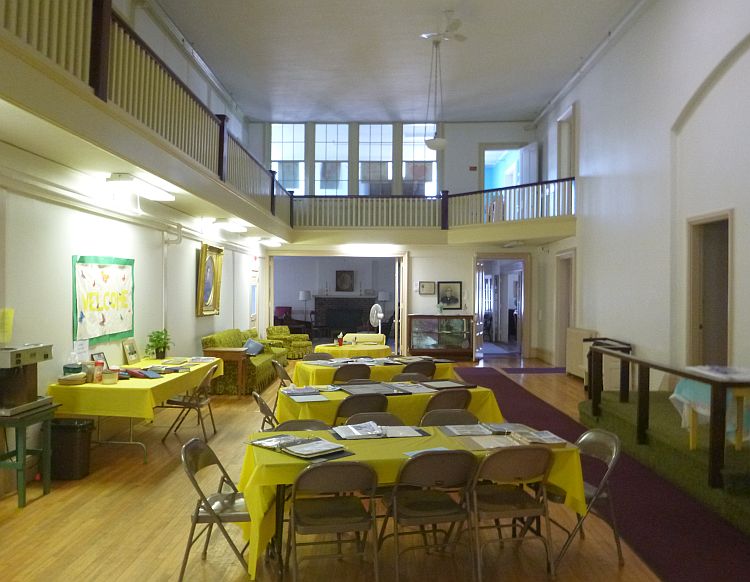
The church's vestry is a long room behind the sanctuary. It is as long as long as the sanctuary is wide. On the tables are scrapbooks with photos and articles about the church's past.
The college's first graduate, George Dana Boardman, Class of 1822, had joined the church while still a student, and after graduating, he went to Burma, becoming the church's and the college's first foreign missionary. Sadly, he died there of a fever in 1931 just days after his thirtieth birthday.
In 1826, the congregation built its church at a cost of slightly less than $4000. Still resting on its original granite foundation, the church is the oldest public building in Waterville and, at 125 feet from the ground to the top of its steeple, is also the tallest building, public or private, in town.
The construction was financed by selling pews, a funding mechanism that seems quaint today but was common at the time. Prices ranged from $35 for a pew in the balcony to $150 for the front row on the main floor. Although the balcony pews were the "cheap seats," the original, central pulpit was so high that the minister's head was level with the floor of the balcony, allowing anyone sitting there to see and hear him clearly.
One did not have to be Baptist to buy a pew; purchasers also included Congregationalists, Methodists, Presbyterians, and Universalists. The most prominent Waterville buyers were Revolutionary War veteran Asa Redington, international tycoon Nathaniel Gilman, and local newspaper publisher Samuel Burleigh. All three now have streets in Waterville named after them, as does Jeremiah Chaplin; and the house that Redington had built on Silver Street is now home to the Redington Museum and the Waterville Historical Society.
Between 1836 and 1904, four separate additions to the church gave it vestries, classrooms, and parlors. There have also been numerous renovations to the main structure over the years, which included lowering the pulpit and removing the pew doors in 1855; replacing the pews altogether in 1875; installing central heating in 1869 and electrical lights 20 years later; building an indoor baptistery in 1871, so that baptisms by immersion would no longer need to be performed in the Kennebec River or the Messalonskee Stream; installing an electric pipe organ in 1926; redesigning the chancel in 1955 to have the pulpit on the right, a lectern on the left, and the altar in the center; and upgrading the organ and moving the pipes to the balcony three years later.
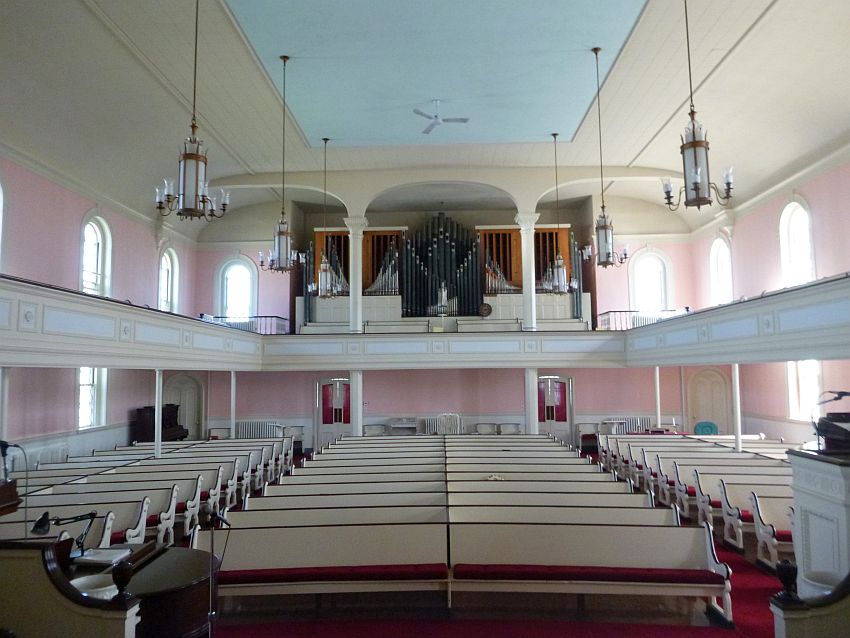
A view of the sanctuary of the First Baptist Church from the chancel. Note the organ pipes in the balcony.
As stated earlier, Colby College and the First Baptist Church grew up together. Following dedication of the new church building on December 6, 1826, every college baccalaureate and commencement was held there until 1918, even though the college closed its Theological Department in 1828 and reconstituted itself as a liberal arts institution. Recall that at the time, Colby, or Waterville College, as it was then known, was located downtown. The campus stretched out along College Avenue, starting just north of the present fire station, a block away from the church.
Although the college was no longer training ministers, it retained its Baptist affiliation until well into the 20th century, and until 1894, hired only Baptists as faculty. Until then, every Colby professor was also a member of the First Baptist Church. Besides Jeremiah Chaplin, two other pastors of the church, David N. Sheldon and George Dana Boardman Pepper, also became presidents of the college, although neither were pastor and president simultaneously. (Pepper, incidentally, was born two years after the death of his namesake.) Several other pastors of the church became Colby trustees.
There are two other noteworthy, 19th-century men with strong ties to both institutions. In 1834, the church called Samuel Francis Smith as its fifth pastor. Smith was also a professor of modern languages at the college. While still in seminary, he had written a new set of lyrics to the British anthem "God Save the King." Formally entitled "America," Smith's patriotic paean is better known today by its first line, "My country, 'tis of thee."
In 1866, the church admitted its first African-American member. A former slave, Samuel Osborne was admitted on his attestation that he had been baptized and had joined a church in Virginia whose records were destroyed during the Civil War. Hired at Colby as its sole custodian, Osborne was also the college's unofficial campus policeman and guidance counselor to students for 37 years, and his daughter Marion was the college's first African American alumna. Last fall, Colby president David Greene renamed the presidential residence the Osborne House in his honor.
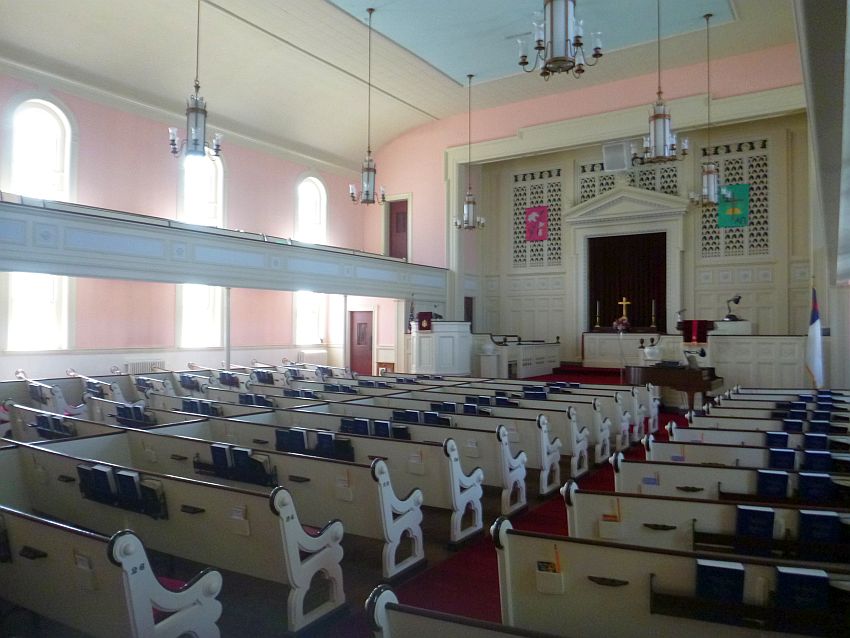
A view of the sanctuary of the First Baptist Church from the right rear, showing the altar.
There is, of course, much more to the history of a 200-year-old institution than can be included in this article. Anyone who wants to learn more may consult its main sources: church secretary Jan Goddard's article in Discover Maine: A Maine History Magazine, Vol. 27, No. 2, 2018 — unfortunately, as of August 2018, the issue containing her article was not online — or Dean Ernest C. Marriner's voluminous History of Colby College, published in 1963.
Today, like many churches, the First Baptist Church sponsors a variety of activities, both sacred and secular. Besides holding regular Sunday morning services, it hosts a shape-note singing group on the second Sunday of each month, the Waterville Chess Club on Monday evenings, a sandwich program on Saturday evenings for those in need, and each Lent since 1990, a series of free, weekly, hour-long organ recitals, in which organists from different area churches play works of their own choosing.
To mark its jubilee, the church is hosting four events. Two of them, a classical music recital in June and a "Tea and Tour" in July, have already gone by; but on September 23, David Brown will give a talk "Remembering Dean Marriner's 'Little Talks on Common Things,'" and on October 21, historian Earle Shettleworth will make a presentation "The Camera Discovers Waterville: The City's First Photographs, 1855 to 1885." Both events take place at 2:00 on their respective Sundays. Admission is free, and refreshments will follow.
Update: Since this article was written, the church has changed its name to "First Church of Waterville" and dropped its Baptist affiliation.
Print Article • Go to Top of Page
A Village Stroll in 1959, Part V
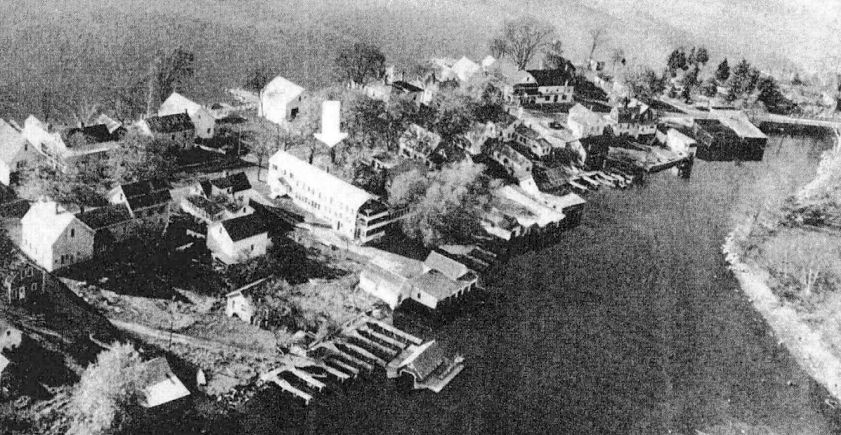
This aerial shot from around 1950 shows the Pulsifer boathouse (bottom left), the Association Docks, and remainder of the shoreline that goes with the houses we covered in Part V. Many buildings, especially boat houses, are now gone.
Let's refresh the location where we ended strolling last week. We had discussed the Pulsifer house and Sybil's Store, then called it quits for the day. So close your eyes and get your head back into 1959 — Open sesame!
There is a very narrow driveway going from Main Street toward the Mill Stream bordering Sybil's store. It can't be more than 10 feet wide and a huge white clapboard wall on the north side gives the sense of walking through a tunnel. The wall is the south side of Maggie and Deke Damren's towering two-story barn.
The narrow drive is the main access "down back" and opens up to a huge lawn once past the buildings. The lawn is partly the Damren's on the north and Pulsifer's on the south, the property line is ambiguous to most. The huge Pulsifer boathouse is straight ahead on the Mill Stream.
This is the path walked by many over past multiple decades, in route to the now defunct Association Docks. The docks were effectively where guides picked up "sports" to take them fishing, the morning hubbub and gathering spot if you will.
Maggie is a local character, loved by all, who is a nurse by trade and is always on-call to the locals. She comes to village homes when asked to render an opinion about someone's sickness. She does everything fast, including driving, and is often in fender benders. She and Deke are hoarders and the huge barn and house are full to the brim. (Deke passes a few years after we are there. Maggie continues on until her house burns to the ground in the winter and she survives several more years in other locations. The MLRC buys the property several years later and builds the current building.)
As we scuffle along and finally pass the north end of the Damren house, a little tar driveway appears. This is Eddie Fletcher's home and barn. As a motorhead local kid, I recognize Eddie's almost new, black Studebaker sedan and note that the body style has changed from the beloved '57 Hawk. Eddie is old and ill and seldom goes anywhere. He is seen sitting on the long glassed-in porch that borders the driveway. Ken Bartlett, ex store owner, is an old friend of Eddie and is occasionally seen driving the black Studebaker when he takes Eddie to doctor's appointments.
(Eddie passes not long after this, Ken B. sees to it that the house is sold and I believe that Dick and Joan Tripp are the next owners. They raise their three children Krishia, KB and Paul there and still own the house today. At the time, Joan's parents, the Smiths, have purchased and remodeled the interior of the stone house across the street.)
Proceeding along a hundred feet or so, we stand in front of a huge old rambling place with a sign hanging on a big steel bracket. It says "Locust House." To our backside, we gawk over our shoulders and see a magnificent view to the west over Long Pond and a gazebo down near the water. This is Ed Megill's hotel that has a number of rooms, a large dining area, and a kitchen down under on the stream side. Ed also owns and lives across the street in The Manor, which acts as an overflow and rentals for more short term customers. The building looks as if it may need more help than it is getting.
Many of the repeat customers that we locals have come to know, stay for one or two months. They rent boats from my father Clifford and hire us kids to take them out fishing. Many of the old guard are too old and fragile to pull the starter cord on the motor or pull up the anchor. We get their bait ready and help them into the boat. This is a dying breed of both customer and facility.
(Not many years after our visit, Ed throws in the towel and Mr. and Mrs. Paul Provandie purchase the building. The next winter several of the local men are hired to completely remodel the place into what became The Village Inn. Currently, it is operated by Kate and Heather.)
We move in a huddle past the north end of the Locust House and a small home stands not far back from the road. I know it as Ray and Florence Barker's home. Their oldest boy is Ray Jr. is one of my classmates. His two younger siblings playing in the yard are Cheryl and Marty. Ray senior is kind enough to tell us the house was moved from Hoyt's Island on the ice many years before. This seems like a feasible story to me, as I know from hunting deer out there, a houseless foundation of granite stones exists on the island.
(The history is confirmed concerning the house once belonging to Adam Hoyt and we all try to imagine the logistics of getting the house across the lake and through the stream — being towed by oxen on precarious ice. The old-timers are magically admired.)
Next, we meander a bit further and another white house sits even closer to the road. It is the home of Frank and Beverly Megill, who not long ago moved into the house and are both working to "fix it up". They have a young child and more on the way. The whole concept of finding and buying an old house for not much money and re-doing it over time was so possible, and opportunities were available.
(Frank and Bev end up raising three girls here in the village. They are Debbie, Judy and Terri. Frank becomes the local carpenter; Bev works for the State in Augusta. They both continue to live here today.)
Moving along, but not far, maybe five giant steps, yet another narrow, but long white house exists. I know it as Uncle Karl and Aunt Florence Johnson's house. Cousins Skip, Karleen and Ruthie are their kids. Karl and Flo run the local marina right beside the house.
This year or shortly thereafter, the Day family who bought the store across the street a year ago, purchase the marina and house. Darryl Day and Linda Tukey Day move into the house and have children Brenda and Jack. The marina grows, needs space, and the house is sold and is moved two miles south on Route 27, where Maurice Childs moves into it. The extra space allows the marina to expand, which it does. (Nearly 50 years later, remnants of that expanded part are what we know as the Post Office today, and the original north side has been removed.)
Wow, we have finally neared our goal. The last two homes on this side of the street before the bridge belong to Everett and Harriet Johnson and Charles Hulin respectively. The Johnson home is small and neat with three small docks on the stream.
Everett once owned the marina that was later run by his son Karl noted above. Everett and Harriet are aging nicely and still go out to "catch some perch" most evenings in the summer.
Everett's primary job in his elder years is to maintain and care take the south end of Hoyt's Island, known as Camp Mandalay. He has worked for the owners Mr. and Mrs. Mitchell for years.
The new owners soon to come are Leonard and Amy Dowse. They buy Everett's house as a land base for parking cars etc., but deed a life estate to him and Harriet. When Camp Mandalay changes hands some 25 years later, the Witkin family continues to use the small home as a mainland base and winter get-away.
In the final gasp here, the large rotund home of retired guide Charlie Hulin appears. A large two-story affair with interesting roof lines and a dormer or two. It is literally in the road's right of way with zero parking space, except for a short driveway at the north end. It has 2 boat house slips for Charlie's boats, but the big old guide boat hasn't been in the water for several years. We local kids have been swimming and fishing along here for years and know what's happening.
Among other things, old guide Fred Ellis likes to come in the boathouse after stopping at the store, pretty much a twice-a-day pilgrimage. He sits on a wooden box in the semi-dark silence and sips a Narraganset. In our earlier years we would plague him in different ways such as stealing a beer or popping up under the lifted boat when he sits there. My father shooed us away from bothering him or else.
(Charlie passes away not long after our visit in '59 and the home is sold. Arthur and Dot Frazier live there for a couple of decades. Other than the missing boathouses, which were taken down over the next two decades as they fell into decay, the basic home appears relatively unchanged.)
Author's Note: Thank you all for following us in our lengthy stroll. I've had some nice comments so I guess at least part of you found it a bit interesting, especially those who have come here for many decades. Thanks too to Mo and Esther who somehow fit it all in to the paper. —Rod J., The Luckiest Boy
Print Article • Go to Top of Page
The Importance of Native Pollinators
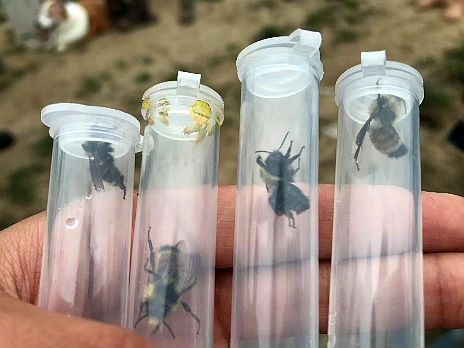
Recently the Knox — Lincoln Soil & Water Conservation District hosted a workshop presented by Eric Venturini (Xerces Society Member and Pollinator expert). A group of farmers, gardeners, and pollinator lovers walked around farm land in Damariscotta, catching and IDing different pollinators on the farm, explaining their habitat and important role they play on the farming industry. Now, you are wondering, what are the different type of pollinators in Maine? Pollinators can be insects, like bees, moths, butterflies, beetles, flies, ants, wasps, and the list goes on. Hummingbirds are also pollinators.
The workshop started with participants collecting bees in a plastic tube to be identified later. There are more than 270 species of native bees in Maine. They all are important for the food production and agricultural industry, like Maine's low bush blueberry, fruit trees, and vegetables crops. Many agricultural producers bring honeybees to do the work, but it is costly for the farmers and stressed the honeybees due to transportation.
Why bring bees when you have native bees and other pollinators available? Native bees have several advantages over honeybees as pollinators. Many are active early in the spring, before honeybee colonies reach large size. They pollinate more plants by flying rapidly and pollinating more efficiently and the native bees would thus free up the increasingly scarce, in-demand honey bees for work elsewhere.
The first and most abundant bee found on the farm was the orange-belted bumblebee (Bombus ternarius). They are one of the first bees out of hibernation in early spring, playing a big role on the various early blooming fruit trees. Another important pollinator found in a squash flower was the squash bee, which specialized in gathering nectar and pollen from flowers on the Cucurbit family: squash, zucchinis, cucumber, pumpkins, and melons, among others. The squash bees are more efficient when it comes to pollinating because they make more contact with reproductive structures in the flower, start earlier in the morning and move rapidly from flower to flower without distracting with other plant species.
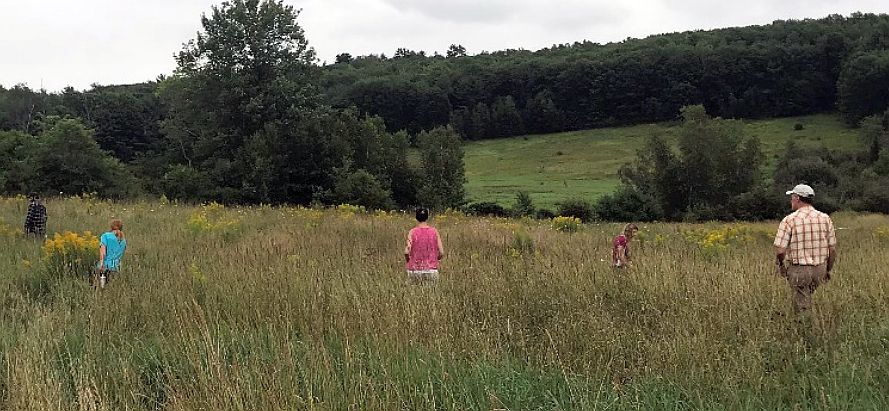
Workshop participants collect different types of pollinators in the field.
Now, what different management pollinator-friendly practices can you do in order to increase pollinators and their habitat? Hold off mowing the spring's dandelion and extend the fall mowing until the goldenrods and asters are done blooming; late fall blooming is the main wintering food source for bees and migrating monarch butterflies. Farmers can reduce the amount of ground disturbance by doing minimum tillage/strip tillage to preserve the habitat of the ground-nester bees. Additionally, reduce the pesticides applications to increase pollinator's population. Hedgerows, thickets, set-asides, trees and snags are habitat components that provide cover and nest sites for many wildlife species. Lastly, plant a variety of diverse plants throughout the growing season for food source, this includes trees, shrubs, wildflowers, and grasses.
Can you imagine a world without flowers? Pollinators are essential in the plant habitat community and play a big role for the food industry. Everyone can do one small thing in order to conserve them.
This week's guest columnist is a soil conservationist at the Augusta field office of the Natural Resources Conservation Service — Maine, a division of the U.S. Department of Agriculture.
Print Article • Go to Top of Page
A Piece of the World

Cover of the hardcover edition of A Piece of the World, by Christina Baker Kline.
All last summer I was looking for this next novel by famed Maine author of Orphan Train, Christina Baker Kline. She presented Orphan Train in Charleston, SC where elementary teachers were familiar with this history of orphans being sent on trains to populate towns at the end of train lines out west. Many children's books on the subject. Finally Kline's novel reached adults, too, with her fine research and interviews of orphan descendants all over the USA.
I read the new library book last fall when A Piece of the World was published. Kline's paperback version was published in the spring with an interesting different view of part of the iconic painting by Andrew Wyeth. My husband Frank and I explored Cushing, Me. several summers ago and we found the Olson House painted in "Christina's World." We walked around the huge ship captain's house and down the hill to the family cemetery near the water. We found Christina's grave.
Christina's crippled body and struggles, the Olson House history, Andrew Wyeth's friendship with the Olson family and the hard, cold Winters are portrayed graphically in this novel. It is not an easy read, but I did reread it before my Charleston book group discussed it in March. I found the second read more pleasurable with the language of summer very soothing in contrast to the harsh difficulties of winter for crippled Christina.
She scrubbed and baked and sewed her own clothes. Christina was a marvel for painter Andrew Wyeth. Betsy Wyeth, Andy's wife, introduced the two and gradually Andy returned everyday with paints and easels, using the empty, second floor of the Olson House as a studio. The simple, basic life of the Olsons spoke to the picture perfect point of view that Andrew Wyeth treasured in his fine art work.
N.C. Wyeth painted in thick oils with bright hues. The Treasure Island classic and many others had his brightly painted covers. Andrew Wyeth, however, as the artist's son, developed a different style. So did Jamie Wyeth, as well, the next generation and third artist of note, all summering in Maine and living most of life in Brandywine, Pa.

Cover of the paperback edition of A Piece of the World.
It wasn't until I read this book twice, thoroughly enjoying the author's personal reflections on the artist and the cripple, that I finally noted Christina in both the author's name and the Olson's daughter's name. Can you believe that? It stunned me because I had not noted it from the get go!
The author lived many winters in Maine, so she could truly convey the trials of Christina Olson. The slight limp in Andrew Wyeth's leg was also depicted and both quiet natures of Andy and Christina. So many beautiful summers are described and sailing was something Christina could do quite well! Disappointments were great and tragedies in the Wyeth family were also included. This novel is historical fiction at its very best, especially if you love Maine.
Some readers may judge Christina's choices harshly, but I found her loving care of elderly parents really quite remarkable. Her brother also helped with the daily chores all year long. The large farm becomes smaller as the four remaining Olsons live out their final days in the huge house. Fields of crops shrink as people age. Winter seems to sap everyone's strength, but finally the lilacs bloom by the door in spring.
Life and warmth returns once again and Andrew Wyeth paints the stark beauty from within the bare and simple Olson House rooms and the huge hill outside. Christina at the bottom of the hill almost looks like a slender model in her homemade lobster pink dress. The paperback reveals a clothesline from the house to the barn with one pink dress flying in the wind, drying on the line. What different perspectives the hardback cover has from that of the paperback. I think Andrew Wyeth would like both covers of this very special historic novel.
Print Article • Go to Top of Page
Mushrooms and Flowers in the Hills

Todd and Nancy Hemphill with Baxter the family dog.
The weather has continued to be variable — mostly hot and humid with a few thundershowers, but occasionally really nice for hiking in the shady woods. There have been a few wet days that haven't done much to raise the water levels in the lakes but at least have brought out a bunch of wild mushrooms for those of us who forage these delicious treats. I spent one afternoon hiking The Mountain with Laura Rose Day, the new CEO of the 7-Lakes Alliance, and we found quite a few black trumpets, which are among my favorites.
The next day I decided to hike into the Kennebec Highlands a bit and stopped at French Mountain on the way to Beaver Brook hoping to find a family with kids hiking the trail. As I pulled into the parking lot I noticed a guy cutting the grass along the edge of the parking lot and along the drainage ditch by the side of the road. I am on the 7-LA Stewardship Committee and didn't remember anyone talking about cutting the grass. I introduced myself to him and discovered that Jon Wathen, who lives across the street from our trailhead, has been cutting our grass whenever he cuts his own and picking up the parking lot at least weekly "for years" because he felt, "it was the right thing to do." It made me realize how special our local community is.

Beautiful cardinal flowers along the stream.
As I was leaving a car with North Carolina plates and a BRCA sticker pulled into the lot. It was Todd and Nancy Hemphill, who have a camp on Flying Pond in Vienna. Nancy has been spending summers here since she was 5. Todd has only been coming for about 40 years, "since he met her."
I then went down Watson Pond Road and hiked into Beaver Pond roughly following the Beaver Brook. My plan was to collect a few mushrooms and do a little fishing in the pond and brook. I brought an ultralight spinning pole and my Tenkara flyrod, a 12-ft long, telescoping Japanese rod that only weighs a couple of ounces and has no reel or guides. The line attaches to end of the rod like the old cane poles many of us first fished with. Both the stream and the pond were as low as I have seen them in 10 years but I caught quite few small bass and fallfish that aggressively hit my fly. The Tenkara rod is fun to use with these small fish and is great for small streams because you don't need a backcast. Check out www.tenkarausa.com or stop at Patagonia or L.L.Bean in Freeport to check it out. I also found some amazingly beautiful stands of cardinal flowers in the stream.
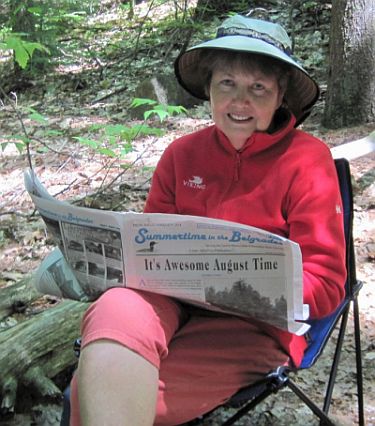
Kaet Held reading the August 3 — 9 issue of Summertime on the French Mountain Trail.
On the way back, I stopped again at French Mountain looking for families with kids. As I walked towards an area where I had found mushrooms before, I glanced up the trail and saw something red about 100 yards up the trail. It looked like someone sitting beside the trail reading a newspaper. I walked up to introduce myself and discovered Kaet Held sitting in a folding chair reading Summertime in the Belgrades. I noticed her paper was open to my column, and I got excited. She then told me how much she was enjoying Rod Johnson's column about strolling through the village in 1959, which was roughly when her family bought a camp on Great Pond and she began coming here. She had started up the hill with her family but was recently recuperating from an illness and decided to just sit down in the shade to read her paper while the rest of them hiked to the top of the hill. She did tell me she also liked my column and was happy to appear in it.
Take advantage of the rest of the summer and get out on the lakes or hike or bike in the hills. And take a kid along. Or take a parent and turn them into a kid again. You will be creating memories that last. Check out the events at the 7-LA website and the sign in front of the Maine Lakes Resource Center in Belgrade Lakes Village.
Print This Article • Print All Articles • Go Back to Top

Download the Print Edition
The print edition includes all the above articles and much more. You can find a complete table of contents on p. 3. Adobe Reader is required.
◀— Previous • All 2018 Issues • Archives • Business Directory • About Us • Home • Next —▶
©2018 by Summertime in the Belgrades. All rights reserved.

